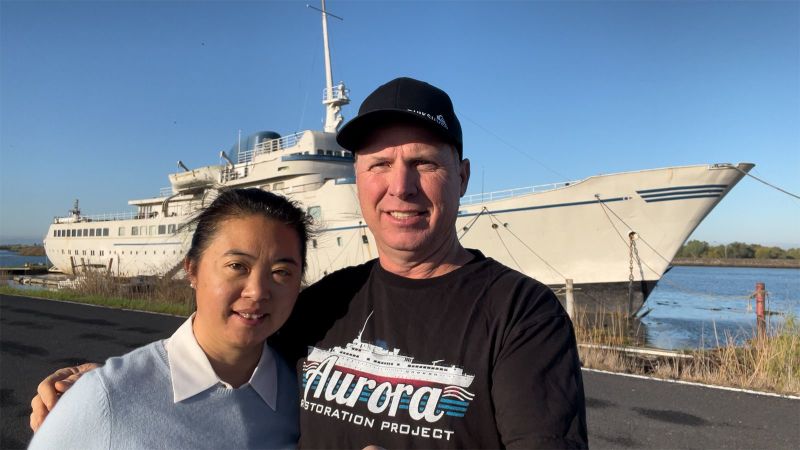CNN
—
It was a passion project that spanned around 15 years and cost over $1 million, but nearly two decades after technology entrepreneur Chris Willson purchased a cruise ship on Craigslist, the vessel has met its end.
The 293-foot ship, which was towed from California city Stockton to nearby peninsula Mare Island in late 2024, has been completely demolished.
Willson, who reluctantly sold the vessel, known as the Aurora, in October 2023, says he’s devastated by the turn of events.
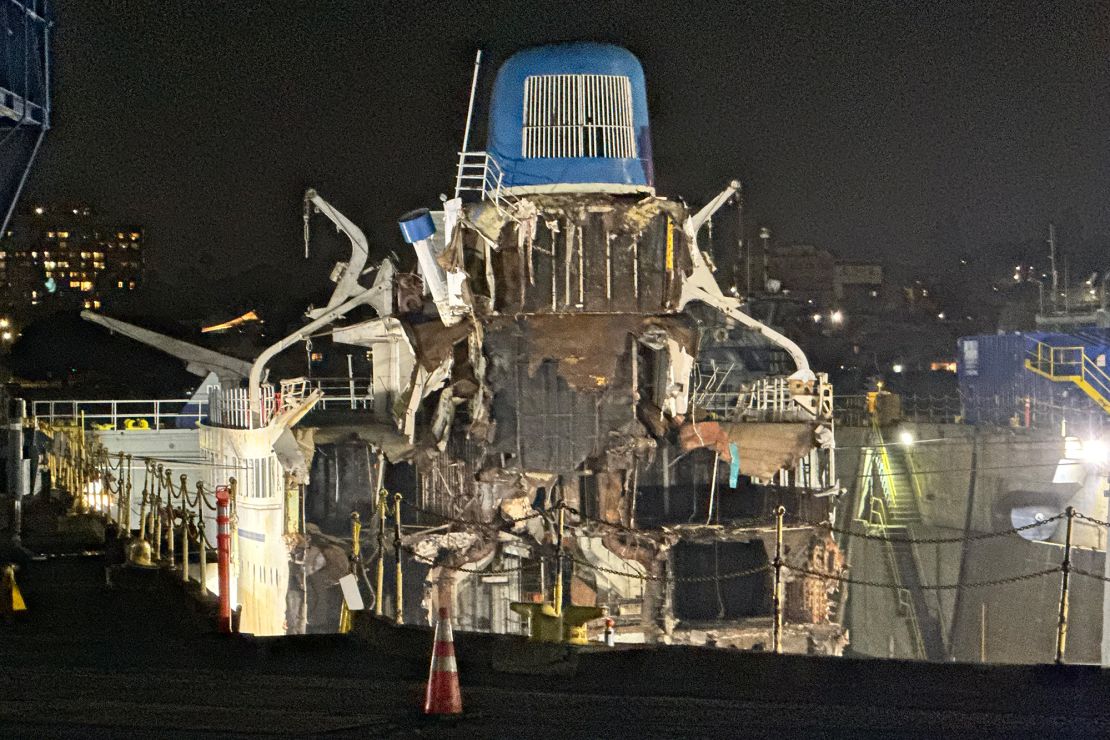
“It’s probably one of the saddest things that I’ve had to witness in this lifetime…” Willson tells CNN Travel.
“It’s hard to watch 15 years of hard work just go to complete waste.”
Cruise historian Peter Knego, who has followed the ship for several decades, is one of the few people to have caught a glimpse of the Aurora after she was towed, and was able to witness some of the painstaking work involved in scrapping it earlier this year.
“They’re demolishing it with these cranes that go in and just grind up the steel,” Knego told CNN last month, pointing out that this is the “safest” method.
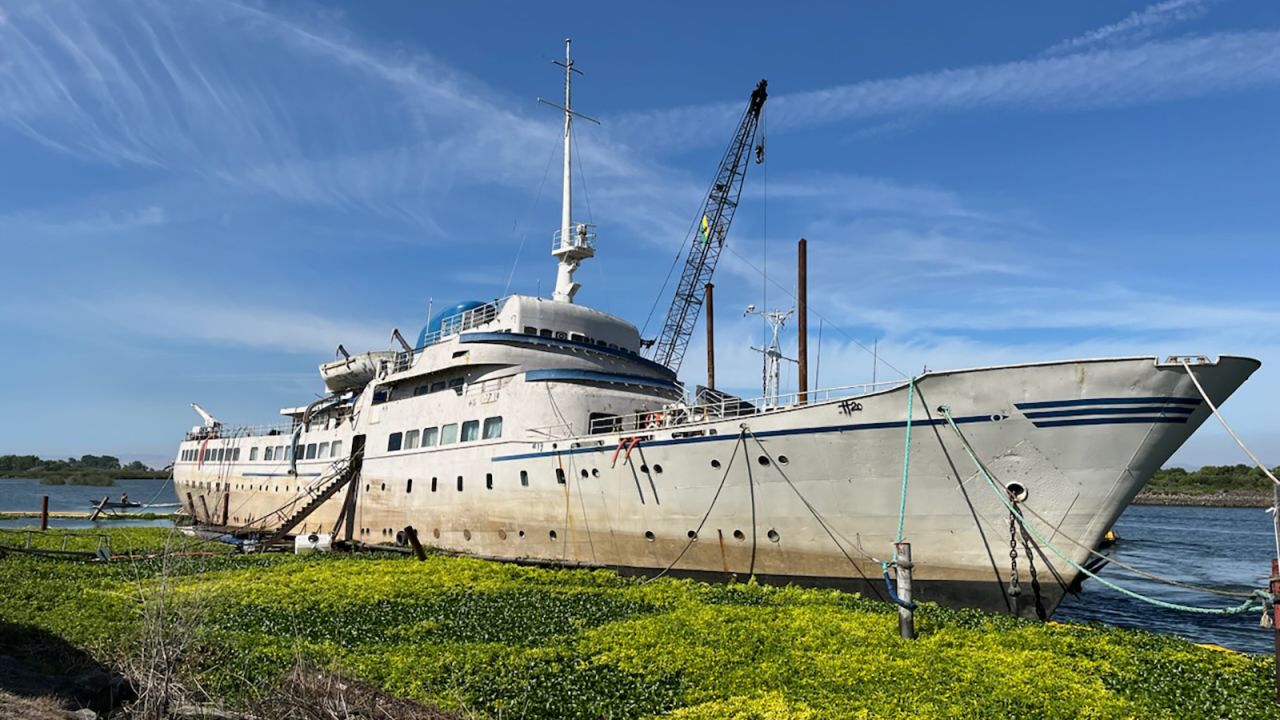
VIDEO: Peter Knego is trying desperately to save the stories of lost ocean liners
“It’s a really mean looking, horrible death for the ship.”
That “horrible death” marks the final chapter in the eventful story of the “pocket” cruise ship, originally named Wappen von Hamburg, which was built by the Blohm and Voss shipyard in 1955 and went on to become the first significant passenger liner built by Germany after World War II.
And while he no longer has any official connection to the vessel, Willson clearly feels a strong emotional tie to the Aurora after claiming to have plowed at least $1 million into the ship and spending nearly 15 years restoring it. He now rues parting company with it.
“If I would have known it would have went this direction, I would have stuck it out,” admits Willson, who previously lived on board the vessel with his long-term partner Jin Li and had hoped to transform it into a museum.
“But, I think it would have been sticking it out to my detriment.”
His long association with the ship began around 17 years ago, when he came across the sale listing on the Craigslist classified advertisements website.
After doing some digging into its history, Willson discovered that the vessel had appeared as the Spectre criminal organization headquarters in the 1963 James Bond movie “From Russia with Love.”
“I started learning some of the history about it,” he says. “And came to find out that it was one of the most historic ships on the planet.”
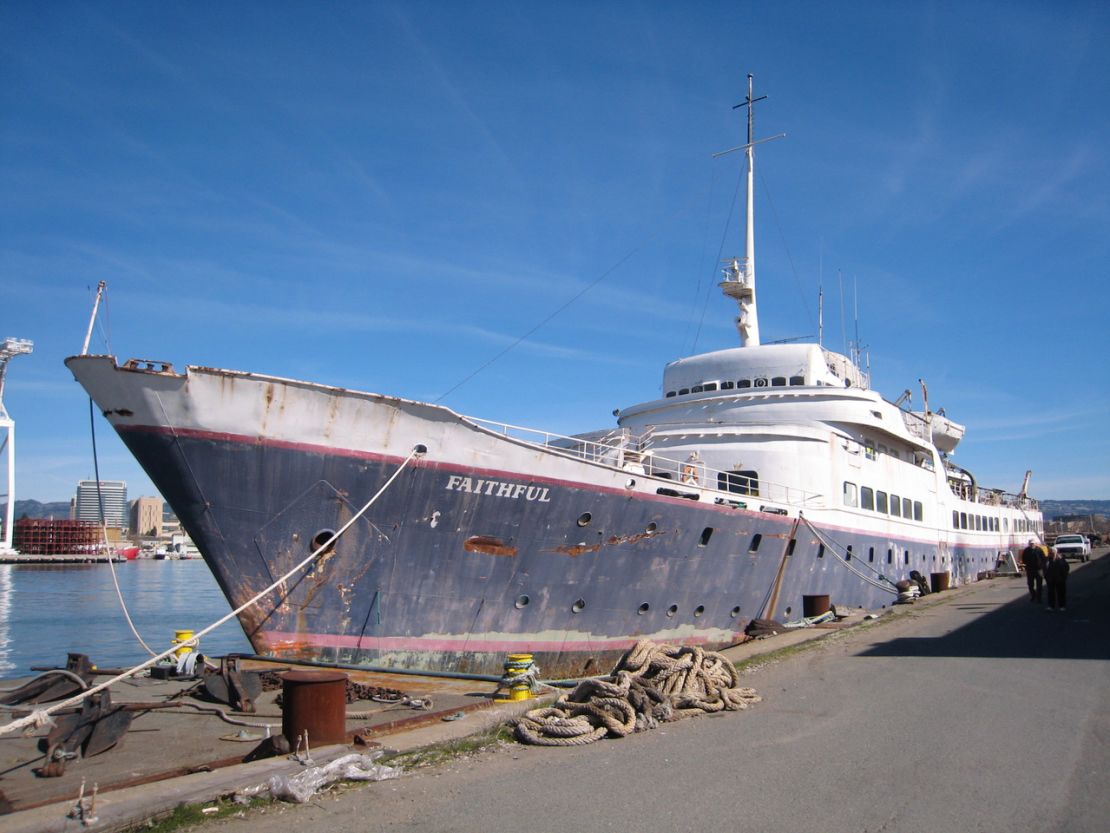
The vessel also served as a cruise ship for around two decades, which is around the time that Knego, whose fascination with ships began when he was a child, first came across it in California.
“At the time, it was this boutique luxury cruise ship decorated with the owner’s wife’s antique collection from Asia,” recalls Knego, who has been sharing updates on the ship on his YouTube channel, Peter Knego’s MidShipCinema.
“So it was kind of a big deal, and I had my dad drive me down.”
Knego says he didn’t see the ship again for many years, until he came across it “anchored off of Long Beach” and had his friends “go circle her so I could take some pictures.”
The ship went through many different owners, as well as names, before being moored in Vancouver.
After a few false starts and even more ownership, and name changes, it was towed to Alameda, California in 2005.
It stayed at the Alameda for several years, until it was relocated to the California Delta and listed for sale on Craigslist, where Willson came across it in 2008.
Although he hasn’t disclosed how much he paid for the ship, Willson previously told CNN that he was able to “work out a really good deal with the owner.”
“I thought I would never see it again,” says Knego, who had spent years traveling the world documenting cruise ships by this point.
“And then all of a sudden, the news came out on Craigslist that Chris Willson had bought the ship. And I was like, ‘Oh my god.’ So I contacted Chris, and we became good friends.”
Willson renamed the ship the Aurora after spending his first night on board and waking up “to one of the most brilliant sunrises I had ever seen.”
“It was forming an Aurora type effect with the clouds and water,” he told CNN back in 2022.
“I remember thinking at that time ‘Aurora’ was a fitting name.”
Willson arranged for the ship to be moved to the California river city of Rio Vista, and it remained there for a year, before he was offered a berth in San Francisco’s Pier 38. However, this arrangement came to an end after around three years.
In 2012, he had the ship transferred back to the California Delta, California’s largest estuary, and moored the Aurora at Herman & Helen’s Marina in Little Potato Slough, located around 14 miles from the city of Stockton in California’s Central Valley.
“We wanted it in fresh water and we wanted it in shallow water,” Willson explained to CNN previously. “So it was absolutely the best possible location that we could have put it.”
Although Herman & Helen’s Marina closed down a few years later, the Aurora remained at the site.
However, Willson says he faced a lot of resistance from locals, who weren’t exactly thrilled to have a huge decommissioned ship moored nearby.
This apparent hostility only worsened when another large vessel, Canadian MineSweeper HMCS Chaleur, which was moored in the same area, sank in 2021.
According to Willson, he received a “three-day notice to quit” on “several occasions,” but local authorities never actually “followed through with an eviction.”
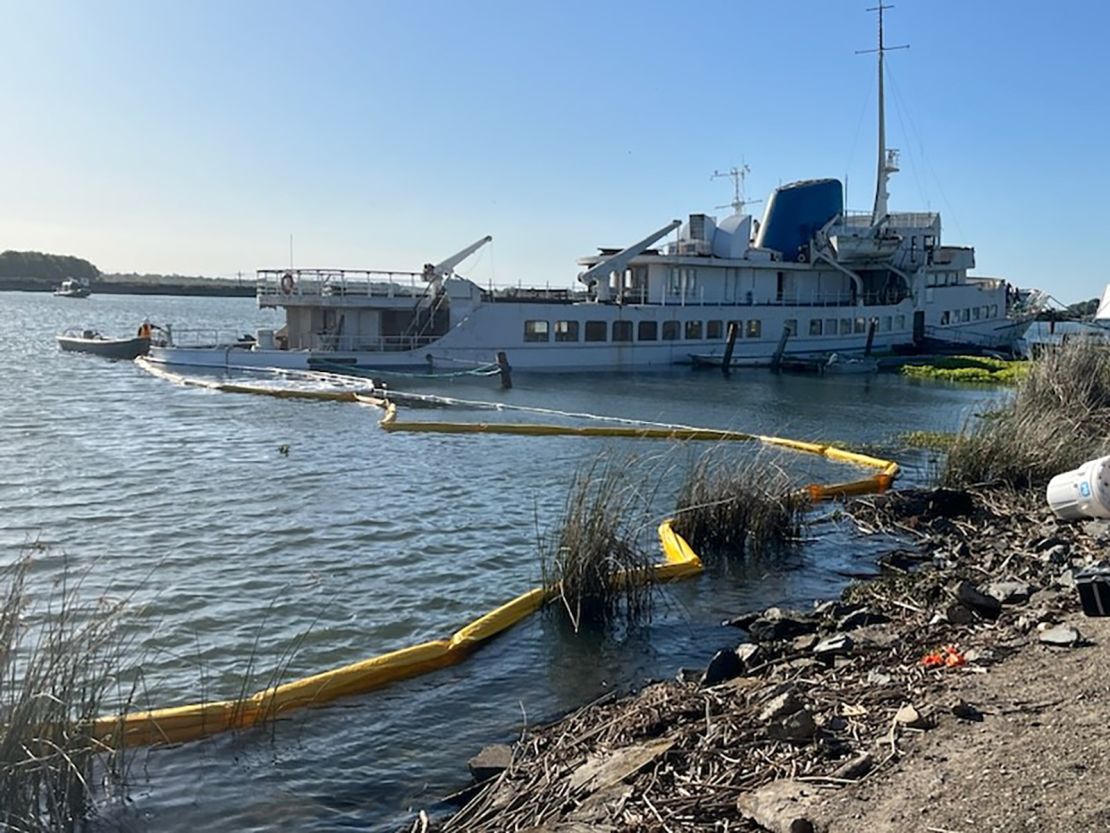
He goes on to explain that things came to a head when 1940s military tugboat Mazapeta, stationed near the Aurora, also sank, creating a “pollution issue,” and various local agencies became involved.
By this stage, Willson conceded that “there was really no future for the Aurora” at that particular spot.
While he considered moving the ship, and looked into various other locations, Willson learned that this would be a costly endeavour.
“The ship was trapped in that channel,” he says. “There was no getting it out without dredging and that’s something that the city would have to do… So there was absolutely no getting out of that situation.”
As time went on and the pressure mounted, Willson felt more and more out of his depth and the situation began to take an emotional toll on him.
Feeling dejected, he says he ultimately chose to sell the Aurora to an interested buyer who seemed just as passionate about saving the ship as he was.
“I didn’t see myself being able to fight that battle anymore,” he says, adding that selling the ship “destroyed” him.
“It became far too in depth for me. And I decided for mental health reasons, just to kind of stay away… To move on and find another project and do something else with my life.”
Willson stresses that he had every confidence that the unnamed individual was capable of keeping the Aurora going, and talked them through how to maintain the ship.
When it comes to the general condition of the Aurora at the time of the sale, Willson explains that while “there were some holes” when he first bought it, they were “patched professionally” and he never had “any problems” afterward.
He stresses that he was as shocked as anyone when it was announced that the ship was sinking around seven months later.
“It has been determined the ship has suffered a hole and is taking on water and is currently leaking diesel fuel and oil into the Delta Waterway,” read a statement from the San Joaquin County Sheriff’s Office posted on X on May 22, 2024.
The US Coast Guard would later confirm that the vessel had been refloated by contractors, noting that it “recently changed ownership.”
Meanwhile, a statement shared by the California Department of Fish and Wildlife’s Office of Spill Prevention and Response on June 28 indicated that contractors had “removed an estimated 21,675 gallons of oily water, 3,193 gallons of hazardous waste, and five 25-yard bins of debris” from the vessel.
The City of Stockton later took over the operation.
When contacted by CNN last year, Stockton Community Relations Officer Connie Cochran said that officials were “figuring out how to dispose of the vessel,” explaining that the size of the ship, along with its location, in an area that wasn’t actually within the city limits, had complicated things.
Cochran also indicated that there “was no clear ownership” for the Aurora when the situation occurred.
Willson has shared the bill of sale and the transfer of ownership document filed with the Coast Guard Vessel documentation center. CNN has put in a Freedom of Information Act request to confirm the change of ownership for the vessel.
CNN was unable to locate the most recent owner for comment.
“It really hurts that I couldn’t jump back in there and save it,” says Willson. “I had no ownership of it.”
Cochran was unable to provide an estimate of the costs for the ongoing operation, which saw various contractors with specialist knowledge brought in, but said that the city was hoping to “recoup” some of it.
In December, the US Coast Guard of Northern California announced that a dead ship tow had been undertaken to move the Aurora to Mare Island, where it would be painstakingly demolished.
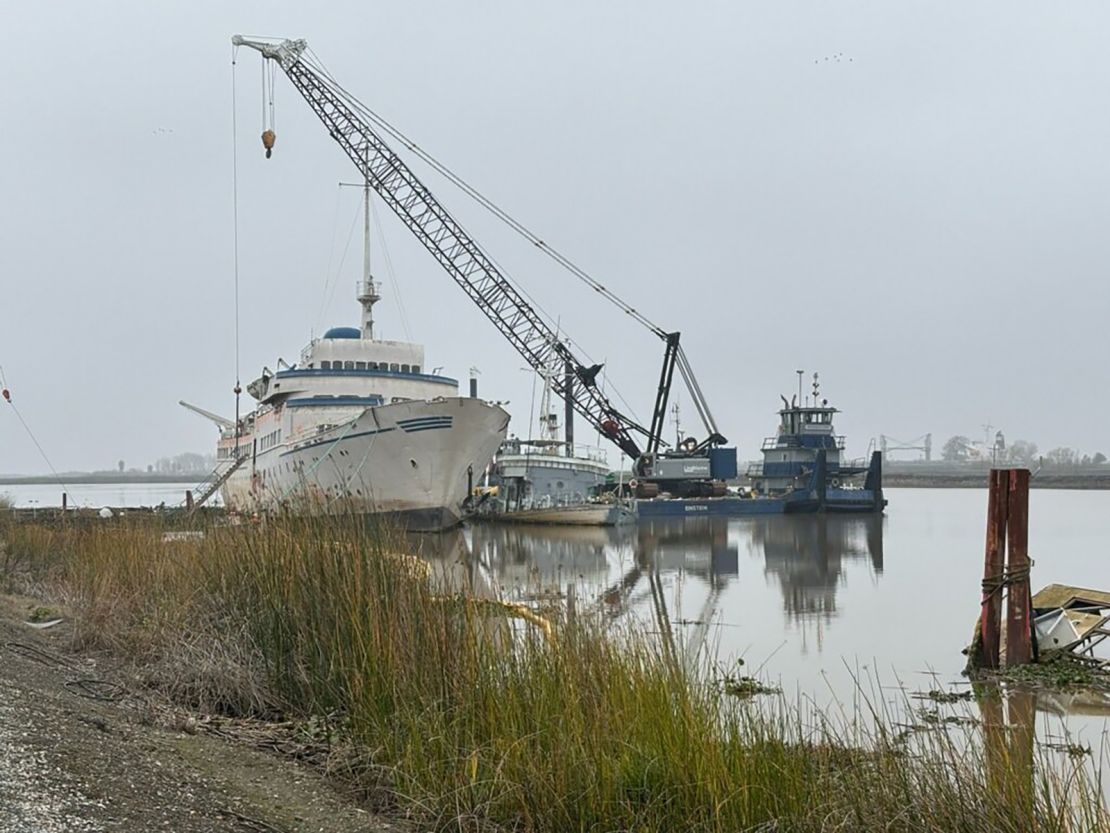
Knego estimates that the entire operation, including hiring tug boats to tow the ship and the dry docking, a process where a ship is brought to dry land so that the submerged portions of the hull can either be cleaned or inspected, would likely have cost between $10 to $20 million.
“It’s a poor city,” he says. “And for them to spend this huge amount of money… People will be angry…
“And the irony is, the ship desperately needed to be dry docked. It hadn’t been dry docked since 1978. Finally, the Aurora gets dry docked, just to be demolished.”
Knego points out that the ship was perhaps worth “a couple hundred thousand dollars in a good market.”
“The city of Stockton has a big loss on their hands,” he adds.
Cochran has since confirmed to CNN that the Aurora is no more.
“It was towed to Mare Island, and as of April 9, 2025, the destruction of the Aurora was complete except for the final disposal of a few key pieces and material,” Cochran told CNN via email.
She went on to state that the city “is working with other government agencies to investigate and identify who was responsible for placing the Aurora in the waterway and allowing it to degrade.”
“The city intends to take all appropriate legal action to recover the city’s costs for the Aurora’s removal and disposal from any responsible parties,” she added.
“We do not, yet, have the final cost.”
When questioned on the costs to the city of Stockton, Willson says he’s frustrated that the authorities decided to scrap the ship.
“It (scrapping the Aurora) was the most expensive way,” he adds.
Reflecting on his decision to sell the Aurora nearly two years ago, Willson concedes that he would have done things differently if he’d known what would happen next.
“Was I willing to go down with the ship?” he reflects. “I mean, I would have worked on that ship my entire life.
“But once they threw a wrench in the works, that kind of ended it for me. I decided, no more.”
While Willson was previously in contact with the most recent owner, he admits that he hasn’t heard from him in a while.
“All of this is a big mystery,” Knego says. “And needless to say, very disappointing…
“I’m kind of sad, because after all these years… The ship turned 70 and it should be preserved. It’s not such a big ship.
“It would have been great if the Germans took her back to Hamburg and restored her.”
To say things haven’t turned out the way he hoped is something of an understatement, but Willson says he’s hugely grateful to have been able to keep the Aurora “afloat” for so many years, describing his time with the ship as the happiest of his life.
“I kept it safe for 15 years, and then I couldn’t see any hope for me working on the project anymore,” he says. “So I passed it on to someone else.”
He’s been heavily criticized for seemingly abandoning the ship and leaving others to deal with the aftermath. But Willson feels that any anger towards him is misguided.
“I don’t think people should be mad at me,” he said. “I think that they should be mad that they allowed it into the Delta to begin with.
“So that’s kind of where I stand on that. I didn’t bring the mess there. I just protected it.”
Willson also points out that “nobody knew what that vessel was” until he bought it and removed several coats of paint to uncover its original name.
“At least I showed that to people for 15 years,” he says, recounting the many happy hours he spent renovating the ship, with the help of volunteers.
A cursory glance at the official Facebook page for the Aurora Restoration Project, which has over 13,000 followers, indicates just how much those who got involved appreciated the opportunity to step on board the historic ship.
“I am just thankful that Chris and his devoted crew gave us a chance to see her one last time,” a user named Steve Young wrote. “I thought that she was toast years ago.”
Another, Clay Byfield, added that he was “sad to see that the Aurora is being put to rest.”
“But having the opportunity to meet you and some of the (at the time) crew will forever be cherished,” he said.
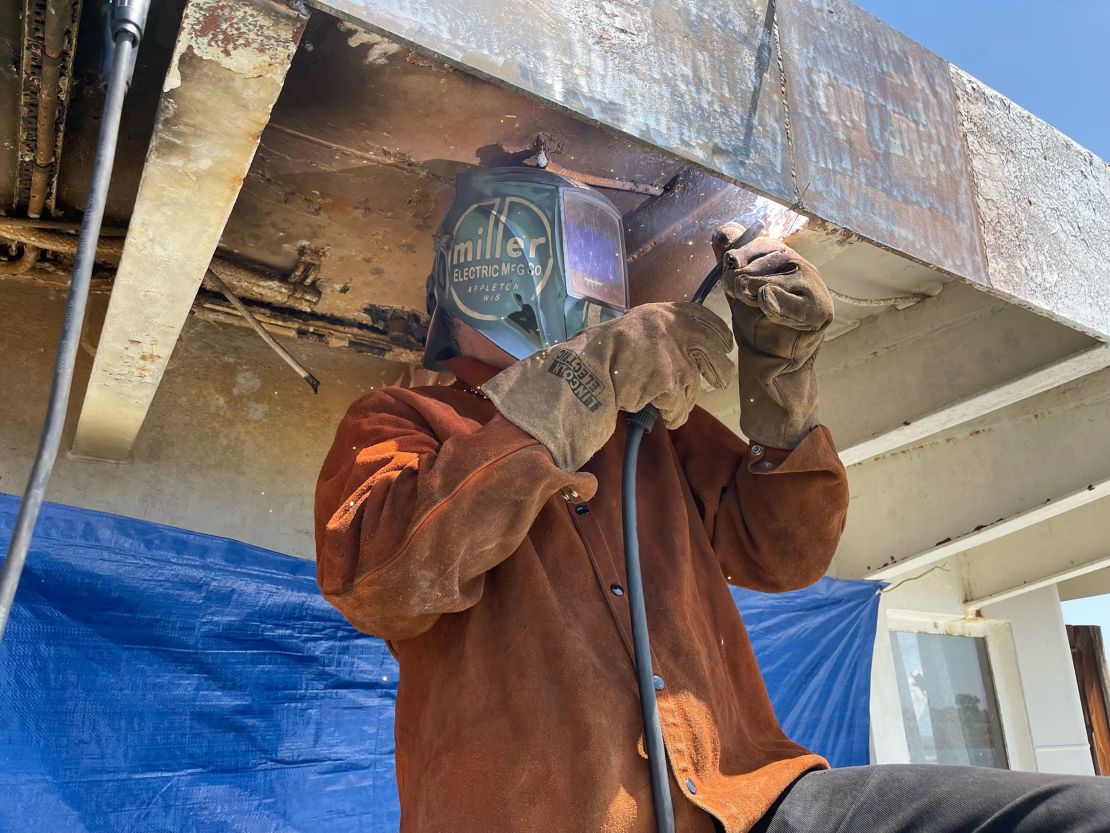
Willson, who also ran a YouTube channel chronicling the progress of the project, believes that the ship would likely “have just sank without anybody not knowing what it was” if he hadn’t bought it all those years ago.
“I think that that’s a happy thing,” he says.
Willson is particularly frustrated that the end of the Aurora has come around the same time that plans are moving ahead for the SS United States, once the largest passenger ship built entirely in the US, to be intentionally sunk to form the world’s largest artificial reef.
“It just seems weird that they’re going down at the almost exact same time.” he says, before adding that he feels that people “aren’t so focused on history anymore.”
“There were only three vintage liners left (in the US)… Now it’s just going to be the Queen Mary (a retired ocean liner moored at Long Beach that’s now a popular tourist attraction).”
Knego is also hugely disappointed by the demise of these historic ships, noting that “only a handful” get saved.
“It’s just beautiful,” he says of the SS United States. “I mean, it’s rusty and it looks like hell. But the bones of the ship are so spectacular.
“And we can’t find a home for this thing?… It sucks if you like ships.”
Knego admits that he once had high hopes for the future of the Aurora, but sadly it wasn’t to be.
“It’s heartbreaking,” he says, before noting that the saga of the vessel is a “great story.”
And while Willson is still coming to terms with the reality that he couldn’t save his beloved ship one final time, he maintains that he has absolutely no regrets about buying it.
“I wouldn’t trade the experience for anything,” he says. “There were so many almosts with that ship.
“We almost had the right people involved in order to save that ship for many, many more generations.
“But things fall through and we just kept waiting for the next one to happen. So I think it was worth it to take the chance.”


